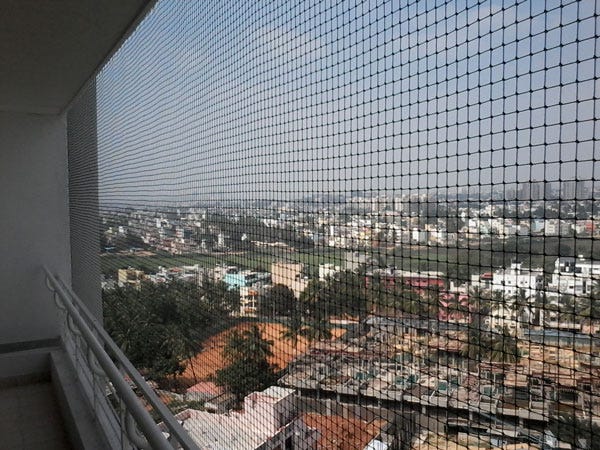Introduction to Bird Safety Nets
Birds are beautiful creatures, but when they invade spaces like balconies, rooftops, warehouses, or agricultural zones, they can cause serious problems. From droppings that damage property to nests that block ventilation systems, the impact can be significant. Bird safety net installation are an effective, humane, and long-lasting solution to keep birds away without harming them. These nets are designed to create a physical barrier while blending seamlessly with the property’s aesthetics.
Why Bird Safety Nets Are Essential
Bird infestations can lead to a variety of problems. In urban areas, pigeons and other birds often roost in buildings, leading to:
-
Health hazards due to droppings carrying bacteria and parasites.
-
Property damage from acidic droppings corroding metal and staining surfaces.
-
Operational interruptions in warehouses or factories.
-
Contamination of stored goods and food products.
Installing bird safety nets provides a proactive approach, preventing these issues before they escalate. Unlike spikes or chemical repellents, nets create a complete barrier without harming the birds.
Custom Solutions for Different Properties
Every property has different needs when it comes to bird-proofing. Rarely does a one-size-fits-all strategy work. Before suggesting a customized solution, expert bird net installers evaluate the building’s structure, exposure to bird activity, and the unique difficulties of the site.
Residential Buildings
In apartment complexes or private houses, bird safety nets are typically installed on balconies, terraces, and open windows. They are made from high-quality, UV-stabilized polyethylene to withstand sun, wind, and rain. The nets are designed to be almost invisible from a distance, ensuring that the view remains unobstructed while providing complete protection.
Commercial Properties
Shopping malls, hotels, and balcony safety net office complexes face challenges in keeping their premises clean and safe for visitors. Bird nets in these locations often need to cover large open spaces without interfering with the architecture. Custom installations may involve specialized fixing methods to integrate the net seamlessly with glass facades and decorative elements.
Industrial Spaces
Factories, warehouses, and production facilities need heavy-duty bird nets to prevent contamination and protect machinery. These nets are usually stronger, with reinforced edges, and designed for high-tension installations that cover large spans without sagging.
Agricultural Areas
Farms and orchards benefit greatly from bird netting, which shields crops from being eaten or damaged. Agricultural bird nets are often large, flexible, and designed for easy removal and storage between harvest seasons.
Materials and Installation Techniques
The quality of materials and installation methods directly impacts the effectiveness and lifespan of bird safety nets.
-
Material Strength: High-density polyethylene (HDPE) is a preferred choice because it is lightweight, weather-resistant, and durable.
-
Mesh Size: The mesh opening is tailored to the species of birds to be excluded. For pigeons, a 25–30 mm mesh is common, while smaller birds require finer mesh sizes.
-
Fixing Methods: Nets are secured using stainless steel hooks, cables, and clamps to ensure they remain taut and stable in all weather conditions.
-
Aesthetic Considerations: Color options such as black, white, or transparent threads help the nets blend with the property’s look.
The Installation Process
Professional bird net installation typically follows these steps:
-
Assessment – Inspecting the site to identify entry points and nesting areas.
-
Design – Measuring the area and choosing the right net size, mesh, and color.
-
Preparation – Installing anchor points and support cables if needed.
-
Net Installation – Stretching and fixing the net securely to cover all gaps.
-
Final Check – Ensuring there are no loose ends or entry points left uncovered.
This systematic approach ensures maximum coverage and minimal disruption during installation.
Maintenance and Longevity
Bird safety nets require minimal maintenance once installed. Occasional cleaning to remove dust and debris, along with periodic checks for wear or damage, will extend their life. A well-installed and maintained net can last anywhere from five to ten years, depending on environmental conditions.
Choosing the Right Service Provider
Selecting a reliable installer is crucial for effective bird control. Look for companies that:
-
Offer site inspections and customized solutions.
-
Use high-quality, UV-resistant materials.
-
Provide warranties on their installations.
-
Have experience with different types of properties.
Conclusion
Installing bird safety nets on commercial, industrial, residential, and agricultural properties is a wise investment. These nets offer a long-lasting, aesthetically pleasing, and compassionate method of preventing bird encroachment, with customized solutions made to meet the particular requirements of each location. Property owners may guarantee long-term protection, cleaner surroundings, and peace of mind—without sacrificing the safety of the birds themselves—by selecting high-quality materials and a professional installation service.

